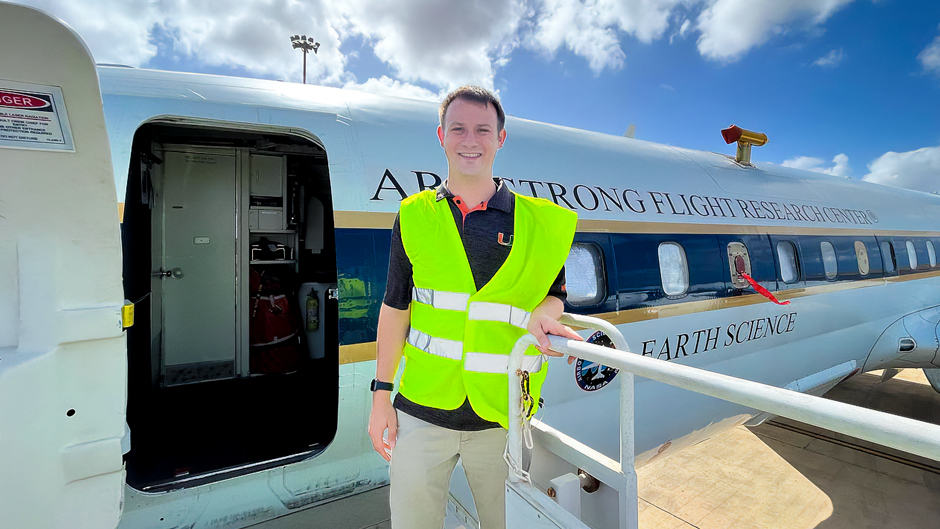From afar, Quinton Lawton could only watch with angst as the first hurricane to strike the coast of his home state of Texas in nine years turned the communities of his childhood into muddy lakes.
It was late August of 2017, and Lawton was an undergraduate living in College Station, Texas, watching video news feeds of the damage powerful Hurricane Harvey had wrought in his hometown of Houston, 95 miles away.
“Many of the neighborhoods where I grew up were underwater, and the National Guard was staging rescue missions out of some of the schools I had attended,” he recalled. “My entire family was living in Houston, and all I could think about was helping in some way to mitigate the impacts of extreme weather on people and communities.”
It was then that Lawton, long enamored with the field of meteorology, decided to immerse himself in tropical cyclone research.
He completed his undergraduate studies in College Station in 2019, then discovered the world-class hurricane research program at the University of Miami Rosenstiel School of Marine, Atmospheric, and Earth Science. He moved to South Florida from the Lone Star State to pursue a Ph.D. in atmospheric sciences and delve deeply into the field of tropical cyclone genesis.
“It’s still an area we struggle with—the timing of and how hurricanes form,” Lawton said. “We’ve gotten a lot better in track and intensity forecasts of hurricanes, and we’re getting a slightly better handle on rapid intensification. But hurricane genesis is still something that often takes us by surprise, especially when we look beyond a few days.”
To help solve the conundrum, Lawton has looked closely at African easterly waves (AEWs), which propagate westward across the Atlantic Ocean and are a key factor in the formation of tropical cyclones and Atlantic hurricanes. “They’re the primary seed of storms that typically form in the Atlantic,” said Lawton, who recently published a study focusing on Kelvin waves and their impact on extreme weather events.
Approximately 60 African easterly waves track across the Atlantic each year, but most never develop into tropical cyclones at all.
Lawton wanted to get a better understanding of why. So, he has looked closely at how AEWs interact with other phenomena in the tropical atmosphere, one of those phenomena being convectively coupled Kelvin waves.
Over 1,000 miles long, Kelvin waves travel in Earth’s atmosphere along the equator and significantly influence global rainfall patterns. Some scientists had long believed that they might affect African easterly waves, but prior to Lawton’s comprehensive Ph.D. studies on the subject, only a handful of studies explored that possibility.
So, during the first phase of his doctoral research, Lawton used reanalysis data of past weather and climate to statistically isolate the role Kelvin waves play in affecting the strength of AEWs. He also conducted controlled experiments with an advanced weather model, testing whether he could strengthen or weaken Kelvin waves in a simulated format.
“The end goal, of course, is that if we can understand the dynamics of these waves, we can build better forecasts and give communities and emergency managers better lead time to prepare,” said Lawton, a former recipient of a prestigious National Science Foundation (NSF) Graduate Research Fellowship. “But we’re equally interested in the role Kelvin waves play in the tropical weather system. In addition to affecting hurricanes, they also bring torrential rainfall and can contribute to major flooding events, especially in Africa.”
Lawton has reported extensively on his findings. In a previous study, for example, he and his faculty advisor, Rosenstiel School professor of atmospheric sciences Sharanya Majumdar, explained how Kelvin waves can encourage tropical cyclone formation in the Atlantic.
And in another, he collaborated with scientists from the NSF National Center for Atmospheric Research (NCAR) to show how increased atmospheric moisture may alter critical weather patterns over Africa, making it more difficult for the predecessors of some Atlantic hurricanes to form.
His work has taken him out into the field. As part of NASA’s recent Convective Processes Experiment airborne field campaign, conducted out of the West African island country of Cabo Verde, he assisted in investigating atmospheric dynamics, marine boundary layer properties, convection, the dust-laden Saharan air layer, and their interactions across various spatial scales. These efforts aim to improve the understanding and predictability of process-level lifecycles in the data-sparse tropical East Atlantic.
“He thinks in great depth about scientific problems, always wanting to understand things to the best level that he possibly can,” Majumdar said of Lawton.
Outreach has been just as important to Lawton as conducting research. He participated in the organization ’Canes on ’Canes during his time at the University, giving scientific talks focusing on meteorology to elementary, middle, and high school students as well as community residents.
With his doctoral degree now secured, Lawton will soon begin a postdoctoral fellowship at NCAR, where he will continue his research in African easterly and Kelvin waves. “I’ll also explore more of the details of the atmospheric complexities that occur off the coast of Africa—work that has been inspired by the NASA field campaign in Cabo Verde,” he said.
The physics of tropical cyclone genesis is an area of investigation without end, Lawton said.
“It’s amazing to me even to this day, long after Hurricane Harvey and actually an earlier storm, Ike, that I experienced as an 11-year-old,” he said. “Hurricane Beryl is a great example of a humbling storm where you think you have all this knowledge, you think you know everything, yet it still finds a way to defy your expectations and to prove you wrong. And that’s because cyclone genesis is so complicated. We’ll discover something, but it will lead to five or six more questions.”

